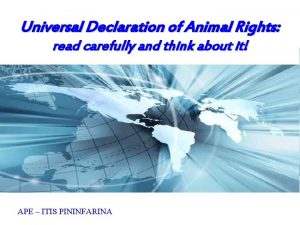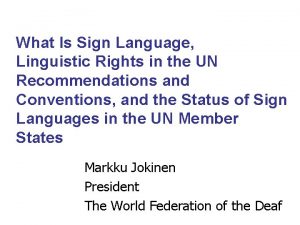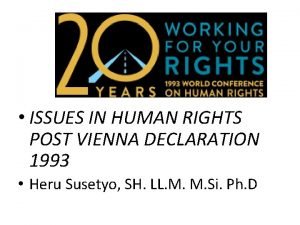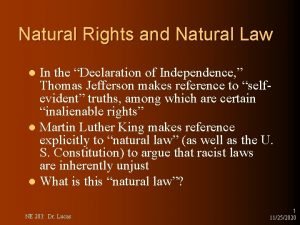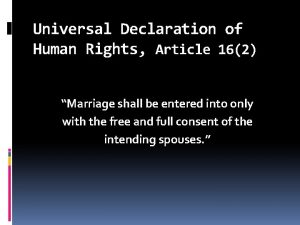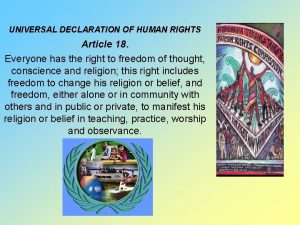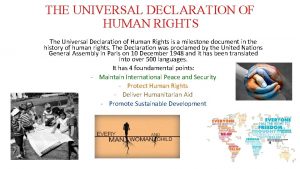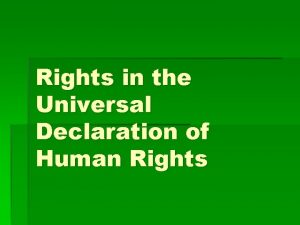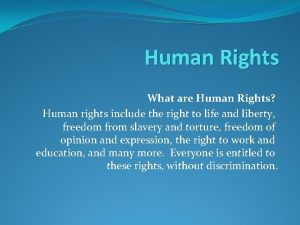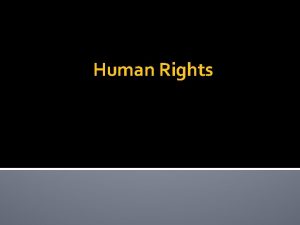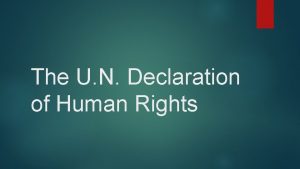Article 12 Universal Declaration of Human Rights Right









- Slides: 9

Article 12 Universal Declaration of Human Rights Right to Private Life and Family Life

Introduction • Very important rights • Private life: each human being is an individual with his or her own personality, desires, dreams, ways of life, … • Family life: human beings are social animals which long for companionship and try to establish a family • Right to private life has become difficult to shield in contemporary societies due to data collection, social media, … • Due to the importance of family within societies, what is a family was and is often very highly regulated and forms part of the public order • The 19 th century traditional family unit (spouses, children, occasionally ascendants) has become the core ideal of family • Challenges to this ideal by non-traditional family units which have been marginalized and villainized • Subject to significant changes over time and ideological “battles” • How have these rights evolved and how do they remain relevant today?

Provisions • Article 12 UDHR: “No one shall be subjected to arbitrary interference with his privacy, family, home or correspondence, nor to attacks upon his honour and reputation. Everyone has the right to the protection of the law against such interference or attacks” • Article 16 UDHR: • “(1) Men and women of full age, without any limitation due to race, nationality or religion, have the right to marry and to found a family. They are entitled to equal rights as to marriage, during marriage and at its dissolution. • (2) Marriage shall be entered into only with the free and full consent of the intending spouses • (3) The family is the natural and fundamental group unit of society and is entitled to protection by society and the State. ” • • Article 17 ICCPR + Article 23 ICCPR Article 8 ECHR + Article 12 ECHR Article 11 ACHR + Article 17 ACHR Article 18 ACHPR (only duty to protect family life)

Contours of the Human Right • Two component rights: right to private life and family life • Right to private life • Right to be left alone? More fundamentally: the individual’s freedom as a self-governing being, who, as long as his freedom does not interfere with society, is not subject to regulation; it includes the right to seek relations with others • Very wide-ranging: from correspondence, to mass surveillance, to a person’s intimacy, identity, name, gender, honour, dignity, appearance, feelings and sexual orientation • Right to family life • Individuals who choose to form a family must be free from interference in family affairs • Related to the right to marry, which the State has to provide by law • If a relationship does not fall within family life, it can still be part of private life • Both rights involve a negative and positive duty • Not absolute: arbitrary interference is prohibited

Right to Private Life • Non-exhaustive scope, which allows to right to be applicable to a wide spectrum of situations and to an evolutionary interpretation • In 1948 the main concern was to protect the home and correspondence and the good social standing of a person (“honour and reputation”) • Over time, right to private life has been successfully relied upon by marginalized groups • Transgender persons: • Rees v. United Kingdom (1986): no violation of right to private life (and right to marry) • B. v France (1992): first time violation of right to private life • Christine Goodwin v. United Kingdom; I. v. United Kingdom (2002): “no significant factors of public interest to weigh against the interest of this individual applicant in obtaining legal recognition of her gender re-assignment” • Garçon and Nicot v. France (2017): making recognition of the sexual identity of transgender persons conditional on undergoing an operation or sterilizing treatment violates the right to private life

Right to Private Life • Homosexual persons • Dudgeon v. United Kingdom (1981); Toonen v. Australia (1994): criminalization of private consensual homosexual acts between adults violates the right to private life • Norris v. Ireland (1988): the mere existence of criminalization of homosexual acts violates the right to private life • Smith and Grady v. United Kingdom (1999): discharge from army because of sexual orientation violates the right to private life • Salgueiro da Silva Mouta v. Portugal (1999): prevention of seeing daughter after divorce because of homosexuality violates right to private (and family) life • Other controversy: Does the right to private life include the right to die? Pretty v. United Kingdom (2002) • Challenge to the right by mass surveillance and collection of data • Klass and Others v. Germany (1978): secret surveillance in the interests of national security and for the prevention of disorder or crime does not necessarily violate the right • Big Brother Watch and Others v. the United Kingdom (2018): bulk interception is incompatible with the right to private life • Aycaguer v. France (2017): mere fact of storing biological data on a person’s private life amounts to an interference; differentiation depending on the nature and/or seriousness of the offence committed; possibility to remove the biological data from a criminal database • Duty to protect personal data on behalf of the State between individuals?

Right to Family Life • Originally the protected mainly the traditional family • Gradually, family life was more broadly interpreted • Marckx v. Belgium (1979): violation of family life for absence of legal bond due to birth between mother and child born out of marriage • Hopu and Bessert v. France (1995): “family” should be given a broad interpretation, so as to include all those comprising the family as understood in the society in question • Pini and Others v Romania (2004): legal ties may under certain circumstances be sufficient • X. Y. Z. v. The United Kingdom (1997): “family” is not confined to blood or marriage and can include de facto relationships; factors: whether the couple live together, the length of the relationship and whether they have demonstrated a commitment to each other by having children together or by any other means • Can non-traditional relationships amount to family life • Schalk and Kopf v. Austria (2010): recognition that same sex couples can have family life • Gas and Dubois v. France (2012): two cohabiting women are not comparable with married couples concerning adoption by the second parent • X. and Other v. Austria (2013): no discrimination in right to family life when the situation was compared with that of a married couple in which one spouse wished to adopt the other spouse’s child, but discrimination with regard to non married heterosexual couples

Right to Family Life • Is there a duty to open marriage to same sex couples • Relevant provisions state “Men and women” v. “Everyone” or “No one” • Schalk and Kopf v. Austria (2010): no duty for states to open marriage to same sex couples, despite them having family life • Vallianatos and Others v. Greece (2013): if State provides for civil unions it must be open to all couples in stable relationship • Orlandi and Others v. Italy (2017): duty of states to provide for legal protection and recognition but not to open marriage • But: Advisory Opinion on Gender Identity, Equality, and Non-Discrimination of Same-Sex Couples (2018): States must extend all existing legal mechanisms including marriage to same-sex couples

Conclusion • The right to private life and family life has been extensively interpreted through the case law • Over time the focus has shifted from protection of the traditional family and the State interest in promoting the traditional family to a more inclusive and individualistic approach to private life and family life • The (r)evolutionary interpretation has not been generally accepted and faced opposition by certain religious groups • It demonstrates the strength of human rights: a universal discourse for all, including marginalized groups
 Universal declaration of animal rights
Universal declaration of animal rights Universal declaration of linguistic rights
Universal declaration of linguistic rights Right product right place right time right price
Right product right place right time right price Right time right place right quantity right quality
Right time right place right quantity right quality Vienna declaration of human rights
Vienna declaration of human rights The right man on the right place at the right time
The right man on the right place at the right time Florida declaration of rights
Florida declaration of rights Natural right
Natural right Negative rights vs positive rights
Negative rights vs positive rights Riparian rights vs littoral rights
Riparian rights vs littoral rights
